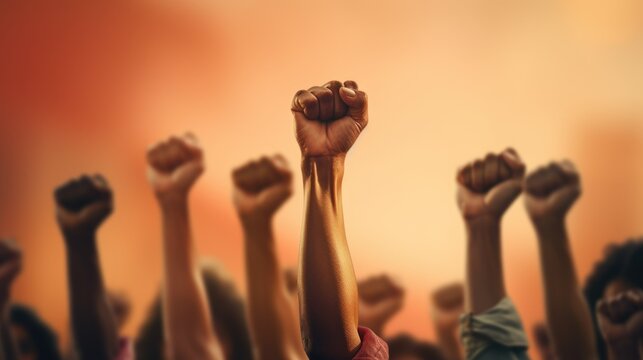3.10 Social Movements and Equal Protection


Table of Contents
ToggleTable of Contents
- Introduction
- Examples of Goals in Social Movements
- Examples of US Social Movements
- Governmental Response to Social Movements
- Voting Rights Act of 1965
- Title IX
- Brown v. Board of Education Supreme Court Case
- Civil Rights Movement (1960s)
- Equal Protection Clause
- Conclusion
- Frequently Asked Questions (FAQs)
- References
Introduction
Social movements are powerful collective actions undertaken by individuals or groups aiming to instigate social, political, economic, or cultural change. These movements can manifest as grassroots initiatives or large-scale protests, driven by diverse motivations such as the pursuit of equal rights, enhanced representation, or the establishment of more equitable policies. Central to many social movements is the principle of equal protection—the notion that all individuals should receive equal treatment under the law, irrespective of race, gender, religion, or other personal attributes. This principle is enshrined in various constitutions and stands as a cornerstone of modern democratic societies, underpinning efforts to achieve justice and equality.
Examples of Goals in Social Movements
Social movements pursue a wide array of objectives, each addressing specific societal issues. Below are some common goals that various movements strive to achieve:
Advocating for Equal Rights
Efforts to secure equal treatment under the law for marginalized communities are foundational to many social movements. This includes advocating for the rights of people of color, women, and members of the LGBTQ+ community, ensuring they receive the same legal protections and opportunities as others.
Promoting Political Representation
Increasing political representation for underrepresented groups is another critical goal. Movements may focus on enhancing voter access, advocating for fair redistricting, and ensuring that diverse voices are represented in governmental bodies.
Advocating for Workers’ Rights
Securing fair wages, safe working conditions, and improved benefits are central aims of labor movements. These efforts strive to protect workers from exploitation and ensure equitable treatment in the workplace.
Protecting the Environment
Environmental movements aim to safeguard natural resources, reduce pollution, and promote sustainable development practices. These movements address issues like climate change, deforestation, and pollution to ensure a healthier planet for future generations.
Advocating for Public Health
Improving access to healthcare, reducing health disparities, and promoting healthy lifestyles are key objectives of public health movements. These efforts seek to ensure that all individuals have the opportunity to lead healthy lives.
Promoting Cultural Preservation
Cultural movements work to preserve the heritage of specific groups, such as indigenous communities, and to foster greater cultural understanding and appreciation. These efforts help maintain diverse cultural identities in the face of globalization.
Advocating for Peace and Non-Violence
Peace movements strive to promote non-violent conflict resolution and reduce violence and war. These movements advocate for diplomatic solutions and the de-escalation of tensions to create a more peaceful world.
Examples of US Social Movements
The United States has been the birthplace of numerous significant social movements, each contributing to societal transformation. Here are some notable examples:
Civil Rights Movement
The Civil Rights Movement of the 1950s and 1960s aimed to end racial discrimination and secure equal rights for African Americans. Led by iconic figures like Martin Luther King Jr. and Rosa Parks, the movement employed nonviolent protests and legal challenges to dismantle segregation and promote racial equality.
Women’s Suffrage Movement
Spanning the late 19th and early 20th centuries, the Women’s Suffrage Movement fought for women’s right to vote. This movement culminated in the passage of the 19th Amendment in 1920, granting women the legal right to participate in elections.
LGBTQ+ Rights Movement
Ongoing for several decades, the LGBTQ+ Rights Movement seeks to secure equal rights and protections for individuals who identify as lesbian, gay, bisexual, transgender, or queer. This movement advocates for legal recognition, anti-discrimination protections, and societal acceptance.
Labor Movement
Dating back to the late 19th century, the Labor Movement strives to improve working conditions, secure fair wages, and enhance benefits for workers. This movement has been instrumental in establishing labor laws and protections that benefit the workforce.
Environmental Movement
Gaining momentum in the 1960s and 1970s, the Environmental Movement focuses on protecting the environment and promoting sustainable practices. Key issues include combating climate change, preserving natural habitats, and reducing pollution.
Anti-War Movement
The Anti-War Movement has emerged during various conflicts, aiming to protest and end wars and military interventions. This movement advocates for peaceful resolutions and opposes the escalation of armed conflicts.
Disability Rights Movement
Beginning in the 1960s and 1970s, the Disability Rights Movement seeks to secure equal rights and protections for individuals with disabilities. This movement works to eliminate barriers and promote accessibility in all areas of life.
Governmental Response to Social Movements
Governments may respond to social movements in various ways, influenced by the nature of the movement, its goals, and the prevailing political and cultural climate. Common governmental responses include:
Reform
Governments may implement reforms to address the grievances highlighted by social movements. This can involve changing laws, policies, or programs to enhance equality and justice. For example, the Civil Rights Movement led to significant legislative changes such as the Civil Rights Act of 1964.
Suppression
In some instances, governments may suppress social movements through force, arrests, or censorship, especially when movements challenge existing power structures or threaten the status quo. This response is often seen in authoritarian regimes or during periods of intense social unrest.
Co-optation
Governments might co-opt the goals of social movements without fully implementing them. This can involve creating committees or advisory bodies that appear to address the movement’s demands while maintaining the existing power dynamics. Co-optation can dilute the movement’s impact and hinder meaningful change.
Neglect
Sometimes, governments choose to ignore social movements, failing to respond to their demands. This can occur when movements are perceived as lacking political influence or when the government deems the issues raised as non-critical. Neglect can lead to prolonged frustration and further mobilization of movement participants.
The government’s response to social movements significantly affects the success and trajectory of these movements. Effective responses can lead to substantial societal changes, while negative responses may result in increased resistance and radicalization of movement participants.
Voting Rights Act of 1965
The Voting Rights Act of 1965 stands as a pivotal piece of federal legislation aimed at eliminating voting discrimination against African Americans and other minority groups in the United States. Enacted during the height of the Civil Rights Movement, the act sought to dismantle barriers such as literacy tests and poll taxes that had historically disenfranchised minority voters.
Key Provisions
- Prohibition of Discriminatory Practices: The act banned voting practices that were intentionally discriminatory, ensuring that all citizens could exercise their right to vote without undue hindrance.
- Federal Oversight: It established federal oversight of elections in jurisdictions with a history of discriminatory practices, ensuring that changes to voting laws did not adversely affect minority voters.
- Legal Enforcement: The act empowered the federal government to enforce voting rights, providing mechanisms for individuals to challenge discriminatory practices in court.
Impact
The Voting Rights Act had a transformative effect on American society by significantly increasing minority voter registration and participation. It dismantled institutional barriers that had long excluded African Americans from the political process, fostering greater political representation and influence for marginalized communities.
Contemporary Relevance
In recent years, the Voting Rights Act has faced challenges and attempts at repeal, with some arguing that its provisions are outdated given the progress made in combating voting discrimination. However, many advocates assert that the act remains essential for protecting voting rights and ensuring equitable access to the ballot box. Ongoing legal debates continue to shape the act’s future and its role in safeguarding democratic participation.
Title IX
Title IX is a federal law enacted in 1972 as part of the Education Amendments to the Civil Rights Act of 1964. It prohibits sex discrimination in any educational program or activity receiving federal financial assistance. Title IX has had profound implications for gender equality in education and beyond.
Key Provisions
- Non-Discrimination: Title IX ensures that no person, on the basis of sex, is excluded from participation in, denied the benefits of, or subjected to discrimination under any educational program or activity.
- Scope of Application: The law applies to all educational institutions from kindergarten through graduate schools, covering areas such as admissions, financial aid, athletics, and employment.
Impact on Athletics
One of the most notable effects of Title IX has been the expansion of athletic opportunities for girls and women. Prior to its enactment, many schools provided unequal resources and opportunities for female athletes. Title IX mandated equal treatment, leading to increased participation in sports and the allocation of comparable funding and resources for female athletic programs.
Addressing Sexual Harassment and Assault
Title IX has also been instrumental in addressing sexual harassment and assault within educational institutions. It requires schools to take preventive measures, respond promptly to complaints, and provide support for victims. This aspect of Title IX has been crucial in fostering safer and more equitable educational environments.
Ongoing Challenges
Despite significant advancements, challenges remain in fully realizing the goals of Title IX. Issues such as inadequate enforcement, disparities in resource allocation, and evolving forms of discrimination necessitate continued efforts to ensure comprehensive compliance and protection under the law.
Brown v. Board of Education Supreme Court Case
Brown v. Board of Education (1954) is a landmark Supreme Court case that declared racial segregation in public schools unconstitutional. This decision was a monumental step in the fight against racial discrimination and a catalyst for the Civil Rights Movement.
Background
The case originated in Topeka, Kansas, where Linda Brown, an African American girl, was denied admission to a nearby white school. Her father, Oliver Brown, joined other plaintiffs in challenging the “separate but equal” doctrine established by Plessy v. Ferguson (1896), which had justified segregation in public facilities.
Supreme Court’s Ruling
In a unanimous decision, the Supreme Court ruled that segregation in public schools violated the Equal Protection Clause of the Fourteenth Amendment. The Court held that “separate educational facilities are inherently unequal,” recognizing that segregation instills a sense of inferiority among African American children that undermines their educational and personal development.
Significance
The Brown v. Board of Education decision dismantled the legal basis for segregation, paving the way for desegregation across various public institutions. It galvanized the Civil Rights Movement, inspiring activists to challenge racial discrimination through both legal means and direct action.
Long-Term Effects
The ruling had far-reaching implications, leading to the gradual integration of schools and other public facilities. It also set a precedent for future civil rights litigation, reinforcing the principle that equality under the law is a fundamental American value.
Civil Rights Movement (1960s)
The Civil Rights Movement of the 1950s and 1960s was a pivotal period in American history, marked by widespread efforts to end racial discrimination and secure equal rights for African Americans. This movement employed a combination of legal challenges, nonviolent protests, and grassroots activism to achieve its goals.
Origins and Inspiration
Inspired by a long legacy of African American activism, including the abolitionist movement and the fight for voting rights, the Civil Rights Movement sought to address systemic racism and social injustice. The landmark decision in Brown v. Board of Education provided a legal framework that empowered activists to challenge segregation and discrimination.
Leadership and Strategies
Prominent leaders like Reverend Martin Luther King Jr. and Rosa Parks became symbols of the movement, advocating for nonviolent resistance and civil disobedience. Strategies included peaceful protests, sit-ins, marches, and boycotts designed to draw attention to racial injustices and pressure the government to enact meaningful reforms.
Key Achievements
- Civil Rights Act of 1964: Prohibited discrimination based on race, color, religion, sex, or national origin in public accommodations, employment, and education.
- Voting Rights Act of 1965: Eliminated discriminatory voting practices, ensuring that African Americans could exercise their right to vote.
- Fair Housing Act of 1968: Banned discrimination in the sale, rental, and financing of housing based on race, religion, national origin, or sex.
Continuing Struggles
Despite significant victories, the Civil Rights Movement did not eradicate all forms of racial discrimination and inequality. Ongoing efforts are necessary to address persistent issues such as economic disparities, policing practices, and systemic racism in various sectors of society.
Equal Protection Clause
The Equal Protection Clause is a pivotal provision within the Fourteenth Amendment to the United States Constitution. It mandates that no state shall “deny to any person within its jurisdiction the equal protection of the laws.” This clause has been instrumental in shaping American constitutional law and advancing civil rights.
Historical Context
Added to the Constitution during the Reconstruction Era following the Civil War, the Equal Protection Clause was designed to protect newly freed slaves from discriminatory state practices, particularly in the Southern states. It aimed to ensure that all individuals received fair treatment under the law, regardless of race or previous condition of servitude.
Interpretation and Application
Over the years, the Equal Protection Clause has been interpreted broadly by the Supreme Court to address various forms of discrimination. Key areas of application include:
- Race: Landmark cases like Brown v. Board of Education have used the clause to combat racial segregation and discrimination.
- Gender: Decisions such as Reed v. Reed (1971) and United States v. Virginia (1996) have applied the clause to address gender-based discrimination.
- Sexual Orientation and Gender Identity: More recent cases have extended protections to LGBTQ+ individuals, ensuring equal treatment in areas like marriage and employment.
- Disability: The clause has been used to challenge discriminatory practices against individuals with disabilities, promoting greater accessibility and inclusion.
Legal Standards
The Supreme Court employs various levels of scrutiny to evaluate cases under the Equal Protection Clause:
- Strict Scrutiny: Applied to cases involving fundamental rights or suspect classifications like race or national origin. The government must demonstrate a compelling interest and that the law is narrowly tailored to achieve that interest.
- Intermediate Scrutiny: Used for cases involving gender discrimination. The government must show that the law serves an important interest and is substantially related to achieving that interest.
- Rational Basis Review: Applied to all other cases, where the government needs to show that the law is rationally related to a legitimate interest.
Contemporary Relevance
The Equal Protection Clause remains a vital tool for addressing discrimination and promoting equality in the United States. It continues to be the foundation for legal challenges against discriminatory practices and laws, ensuring that all individuals receive fair and equal treatment under the law.
Conclusion
Social movements play a crucial role in driving societal change, advocating for justice, equality, and the protection of individual rights. The principle of equal protection, enshrined in the Fourteenth Amendment, serves as a fundamental pillar supporting these movements, ensuring that all individuals are treated fairly under the law. Throughout history, social movements such as the Civil Rights Movement, Women’s Suffrage Movement, and LGBTQ+ Rights Movement have leveraged the Equal Protection Clause to challenge discrimination and promote inclusivity.
Governmental responses to these movements have varied, ranging from reforms and co-optation to suppression and neglect. The effectiveness of these responses significantly influences the success and trajectory of social movements. Landmark legislation and Supreme Court decisions, such as the Voting Rights Act of 1965, Title IX, and Brown v. Board of Education, have been instrumental in advancing the goals of social movements and securing equal protection for marginalized communities.
Despite significant progress, ongoing efforts are essential to address remaining inequalities and ensure that the ideals of equal protection are fully realized. Social movements continue to adapt and evolve, striving to create a more just and equitable society where all individuals can thrive.
Frequently Asked Questions (FAQs)
1. What are social movements?
Social movements are collective actions taken by individuals or groups to bring about social, political, economic, or cultural change. They can range from grassroots efforts to large-scale protests.
2. What is the principle of equal protection?
The principle of equal protection asserts that all individuals should be treated equally under the law, regardless of race, gender, religion, or other personal characteristics. It is a key component of many social movements.
3. What are some common goals of social movements?
Common goals include advocating for equal rights, promoting political representation, securing workers’ rights, protecting the environment, improving public health, preserving culture, and advocating for peace and non-violence.
4. How did the Civil Rights Movement impact American society?
The Civil Rights Movement led to significant legislative changes, such as the Civil Rights Act of 1964 and the Voting Rights Act of 1965, which ended segregation and secured voting rights for African Americans.
5. What was the significance of the Voting Rights Act of 1965?
The Voting Rights Act of 1965 banned discriminatory voting practices and provided federal oversight of elections in areas with a history of discrimination, significantly increasing minority voter participation.
6. What is Title IX?
Title IX is a federal law that prohibits sex discrimination in educational programs and activities receiving federal funding, ensuring equal opportunities for all genders in education.
7. What was the impact of Brown v. Board of Education?
Brown v. Board of Education declared segregation in public schools unconstitutional, overturning the “separate but equal” doctrine and paving the way for desegregation.
8. How does the Equal Protection Clause protect individuals?
The Equal Protection Clause prohibits states from denying any person within their jurisdiction equal protection of the laws, serving as a basis for challenging discriminatory practices.
9. What are some governmental responses to social movements?
Governments may respond by implementing reforms, suppressing movements, co-opting their goals, or neglecting their demands, depending on the movement’s nature and context.
10. Why is the Equal Protection Clause important today?
The Equal Protection Clause remains crucial for addressing ongoing discrimination and ensuring that all individuals receive fair and equal treatment under the law.
References
- The Voting Rights Act of 1965 – U.S. Department of Justice
- Brown v. Board of Education, 347 U.S. 483 (1954)
- Title IX and Sex Discrimination – U.S. Department of Education
- Civil Rights Movement – History.com
- Gideon v. Wainwright, 372 U.S. 335 (1963)
- Equal Protection Clause – Legal Information Institute, Cornell Law School
- Title IX Overview – National Women’s Law Center
- Civil Rights Act of 1964 – U.S. Government Publishing Office
- Social Movements in the United States – Encyclopedia Britannica
- LGBTQ+ Rights Movement – Human Rights Campaign
Recent Posts
- Cumulative GPA Calculator
- High School GPA Calculator
- Comparison in the AP Histories
- 2.6 Environmental Effects of Trade
- Character Change
- Hardest and Easiest AP Classes
- 4.4 Maritime Empires Established
- Relic Boundary
- Placemaking
- Contemporary Society
- 3.10 Social Movements and Equal Protection
- Best HBCU Schools in America
- 2.4 Trans-Saharan Trade Routes
- 3.8 Amendments: Due Process and the Rights of the Accused
- East Indies
Choose Topic
- ACT (15)
- AP (20)
- AP Art and Design (5)
- AP Physics 1 (1)
- AQA (5)
- Banking and Finance (1)
- Biology (13)
- Business Ideas (68)
- Calculator (67)
- Chemistry (3)
- Colleges Rankings (34)
- Computer Science (4)
- Conversion Tools (135)
- Cosmetic Procedures (50)
- Cryptocurrency (49)
- Edexcel (4)
- English (1)
- Environmental Science (2)
- Exam Updates (1)
- Finance (17)
- Fitness & Wellness (164)
- Free Learning Resources (189)
- GCSE (1)
- Health (107)
- History and Social Sciences (87)
- IB (1)
- IGCSE (2)
- Image Converters (3)
- IMF (10)
- Math (39)
- Mental Health (58)
- OCR (3)
- Past Papers (463)
- Physics (5)
- SAT (36)
- Sciences (1)
- Short Notes (5)
- Study Guides (26)
- Syllabus (19)
- Tutoring (1)
Recent Comments



2.6 Environmental Effects of Trade





